Military Studies > EXAM > Primary Professional Military Education (Enlisted) Block 2 The Culture of the Navy LATEST COPY (All)
Primary Professional Military Education (Enlisted) Block 2 The Culture of the Navy LATEST COPY
Document Content and Description Below
PPME Block 1-7 (test-bank) Primary Professional Military Education (Enlisted) Block 2 The Culture of the Navy RED: THIS IS THE ANSWER ENLISTED PROFESSIONALISM SECTION 1: CHIEF PETTY OFFICER HIST... ORY, DUTIES, AND RESPONSIBILITIES 1. The only article of the CPO uniform described in the 1897 Uniform Regulations was the? ** hat device 2. Which regulation established the grade of chief petty officer on 1 April 1893? ** U.S. Navy Regulation Circular Number 1 3. On 23 May, 1978, the CNO approved new roles and responsibilities for a chief petty officer. Which of the following was a defined role? ** The top technical authority and expert within a rating 4. The CNO/MCPON Advisory Panel was established in 1971 to? ** Represent the enlisted force to Navy leadership on professional and personnel issues 5. The Career Compensation Act of 1949 established what significant change? ** It designated chief petty officers as paygrade E-7 instead of paygrade 1 6. What initiative led directly to the recommendation for establishing the billet of Master Chief Petty Officer of the Navy? ** The Retention Task Force of 1964 7. In the early 1900’s Sailors of all rates were promoted to fill what first? ** Voids in critical Navy billets, normally in their own command 8. During the early 1900’s chief petty officers could receive a permanent appointment based on? ** Satisfactory performance, as evaluated by the commanding officer 9. On 28 April 1967, ____________ became the first Master Chief Petty Officer of the Navy. ** GMCM Delbert Black 10. What is not a responsibility of the Master Chief Petty Officer of the Navy? ** Report directly to the Chief of Naval Personnel on enlisted retention rates 11. On 13 January 1967, GMCM Delbert Black was officially appointed as the first? ** Senior Enlisted Advisor of the Navy 12. The duties and responsibilities of a master chief petty officer in 1978 were? ** broadened to include contributing to command-level policy formulation 13. The paygrades of senior chief and master chief petty officer were established in what year? ** 1958 14. The Chief Petty Officer Core Competencies were developed to? ** Strengthen chief petty officer standards 15. According to the 1918 BlueJacket’s Manual, two roles of a chief petty officer were ______ ** Technical expert and example setter SECTION 2: OVERVIEW OF MANPOWER MANAGEMENT 1. How often is the Enlisted Distribution and Verification Report (EDVR) published? ** Monthly 2. The AMD is a single source document that provides ________________. ** quantitative and qualitative manpower requirements 3. OPNAVINST 1300.15, Navy Military Personnel Assignment Policy, states Navy policy is to make only permanent change of station (PCS) moves necessary for ________________________. ** national security and/or to ensure equitable treatment of Sailors 4. OPNAV Instruction 1000.16, Manual of Navy Total Force Manpower Policies and Procedures, defines manpower management as a ______________. **methodical process 5. In manpower management, commands are responsible for what? ** Submitting requests to revise, add, or delete requirements 6. Which statement defines Projected Operational Environment (POE)? ** Environment in which a command is expected to operate 7. Placement is an advocate for________ and detailers are advocates for__________. ** Commands, Sailors 8. Which document provides the present and future enlisted manning of a command? ** Enlisted Distribution and Verification Report (EDVR) 9. TFFMS provide access to current manpower data for? ** resource sponsors 10. Changes to the AMD can come from what factors? ** Changes in mission or equipment/systems added or deleted from the platform 11. Manpower management determines manpower authorization priorities based on available funding and ______________. ** personal inventory 12. Where do you find current and future peacetime and mobilization manpower requirements and authorizations? ** Activity Manning Document (AMD) 13. Who prepares the statements detailing Required Operational Capability (ROC)? ** Mission and warfare sponsors 14. For whom does the Personnel Readiness and Support branch (PERS 4013) perform placement functions? ** Enlisted 15. The methodical process of determining, validating, and using manpower requirements as a basis for budget decisions defines ______________. ** manpower management 16. What is the single authoritative database for MPN manpower authorizations and end strength? ** Total Force Manpower Management System (TFFMS) 17. Where do you find personnel strength planning, recruiting, training, and personnel distribution? ** AMD 18. Which document defines military manpower authorizations allocated to a naval activity? ** AMD SECTION 3: THE FLEET RESPONSE PLAN 1. “Presence with a purpose” provides what? ** Routine deployments in support of specific combatant commander objectives or on shorter “pulse” employment periods 2. Which report issued a mandate for the U.S. military to transform leading to adoption of FRP? ** 2001 Quadrennial Defense Review 3. Who did Admiral Vern Clark task with developing a plan to replace the 18-month inter-deployment training cycle (IDTC)? ** Commander, Fleet Forces Command 4. When is a CSG considered surge ready? ** When they have completed integrated phase training 5. The Fleet Response Plan is often referred to as what? ** Fleet Readiness Plan 6. What time frame does the Fleet Response Plan use as its cycle? ** A 27-month cycle 7. At its core, the Fleet Response Plan is? ** a mission driven, capabilities-based response plan 8. The Fleet Response Plan calls for how many carrier strike groups to be deployable within 30 days? ** 6 9. When is a ship, sub, or squadron considered routine deployable? **After successfully completing all necessary capabilities training including completion of underway sustainment phase training and certification of the unit for forward deployed operations 10. Which Sea Power 21 initiative changed the way the U.S. Navy deploys and trains the Fleet? ** Sea Basing 11. What does the 6 + 2 plan provide? ** 6 CSGs available to deploy within 30 days plus 2 CSGs available to deploy within 90 days 12. Due to the war on terror, Secretary of the Navy England challenged the U.S. Navy to do what? ** Maintain its relevance 13. Under the 27-month Fleet Response Plan, a carrier strike group is surge ready for how many months? ** Approximately 16 months 14. The flexible deployment concept allows units that have attained high readiness to embark on deployments in support of specific national priorities such as _______________. **homeland defense, multi-national exercises, security cooperation events, deterrent operations, or prosecution of the Global War on Terrorism 15. When is a CSG considered in emergency surge status? ** When they have successfully completed their unit level phase training phase SECTION 4: MILITARY FORMATIONS 1. What order allows room for the inspecting party to step between ranks to conduct an inspection of the Sailors? ** Open ranks 2. What type of command is the first word in “Parade Rest”? ** Preparatory 3. Traditionally, awards are handed out in what manner? ** From most senior award to most junior 4. As a leader, you can only command Sailors to the position of parade rest, from what position? ** Attention 5. Drill instills discipline and fosters what kind of habits? ** Precision and automatic response 6. During the Revolutionary War, ______________ developed a set of standardized drills for General George Washington and the Continental Army. ** Baron von Steuben 7. Which of the following is NOT a reason to conduct a personnel inspection? ** To use as a tool to punish your Sailors 8. As a leader, you will organize your Sailors into formation for which one of the following occasions? ** Awards ceremony 9. Which event would NOT require the Commanding Officer to order the ship to man the rails? ** Leaving the shipyards after 120 days 10. Who is known as the “Drillmaster of the American Revolution”? ** Baron von Steuben 11. At the beginning of the Revolutionary War, ______________ was the leaders' primary tool to achieve discipline in ranks. ** fear 12. What do you call the extreme right or left of an element? ** FLANK 13. Sailors are in a _____________, when placed in formation one behind the other? ** File 14. Which of the following events would not require you, as a leader, to hold military quarters? ** Refueling evolution 15. What is the distance between ranks? ** 40 16. A/an__________ can be a single person or a section of a larger formation. ** Element 17. When giving a command, what do you call the rise and fall of the pitch in your voice? ** inflection 18. What order allows room for the inspecting party to step between ranks to conduct an inspection of the sailors? ** OPEN RANKS 19. As a leader, which situation would cause you to expect a personnel inspection of your Sailors? ** Prior to the seasonal uniform change SECTION 5: MILITARY UNIFORMS, CUSTOMS, AND COURTESIES 1. When in a military vehicle and an officer is seen, who renders the hand salute? ** The right front passenger seat salutes 2. What should you do when the national anthem of a friendly foreign? ** Salute 3. The Air Force rank associated with its highest enlisted pay grade is that of ? ** Chief Master Sergeant 4. How do you recognize the Sergeant Major of the U.S. Army? ** The hat insignia and rank insignia contain the eagle from the great seal 5. What does Title 10, U.S. Code mandate with respect to uniforms? ** The requirement to generate, maintain, and update the uniform regulations 6. When walking with a senior, what side do you walk on? ** LEFT 7. Who exits a military vehicle first? ** The senior leaves first 8. What is the U.S. Army’s highest enlisted pay grade? ** Sergeant Major 9. What is meant by “under arms”? ** When wearing a side arm or carrying a weapon 10. At what distance do you begin your salute when approaching an officer? ** At six paces or closest point of approach. 11. What is the definition of “prescribable items”? ** Uniform items which may be directed or authorized for wear with the basic uniform. Items may be worn with basic uniforms at the individual’s discretion unless otherwise directed. 12. What Army rank is associated with the E-6 pay grade? ** Staff Sergeant NAVY FLEETS SECTION 1: INTRODUCTION TO NAVY FLEETS NO QUESTIONS SECTION 2: SECOND AND FOURTH FLEETS 1. The Atlantic Squadron was reorganized into the Atlantic in early 1941, because ______________. ** Of the possibility of war breaking out in both the Atlantic and Pacific oceans 2. Which statement is accurate concerning the Battle of Santiago during the Spanish-American War? ** The U.S. Navy obtained a lopsided victory in which every Spanish ship was either sunk or run aground. 3. Among the Navy’s roles during the First World War was ______________. ** All the answers are correct. 4. The opening of the Panama Canal enabled U.S. warships to transfer between the Atlantic and Pacific oceans ______________. ** in less one-third the time 5. During World War II, ______________ numbered fleets were responsible for operations in the Atlantic Ocean. ** three 6. Select True or False: U.S. warships enforced the blockade during the 1962 Cuban Missile Crisis by sinking all Soviet-flagged vessels approaching the island. ** False 7. Navy units operating in the eastern Atlantic during the Second World War ______________. ** All the answers are correct. 8. What was the Navy’s primary duty during the Civil War? ** Blockade the Confederate Coast. 9. When conducting operations within its own AOR, Second Fleet is under the operational control of ______________. ** USNORTHCOM 10. What does the term “CHOP” stand for? **Change of Operational Control 11. The Fourth Fleet’s normal area of responsibility (AOR) is within which geographic combatant commander’s AOR? ** USNORTHCOM 12. Where is the headquarters for the U.S. Navy’s Second Fleet located? 1. What command, now known as USCENTCOM, was formed to underscore the U.S. policy laid out in the “Carter Doctrine”? ** Rapid Deployment Joint Task Force (RDJTF) 2. About ______________ of the oil exported from Fifth Fleet’s area of responsibility (AOR) transits through the Strait of Hormuz— a vital choke point. ** 90% 3. Over ______________ of the world’s oil reserves are located in the area of responsibility (AOR) of the Fifth Fleet. ** 50% 4. Operation NEW DAWN symbolizes ______________. ** the diminishing role of U.S. forces in Iraq 5. Which of the following is NOT a choke point found in the Fifth Fleet’s area of responsibility (AOR)? ** Malacca Strait 6. How many operational units are permanently assigned to the Fifth Fleet? ** 0 7. The Navy’s Fifth Fleet is part of ______________. ** USCENTCOM 8. The focus of Operation NEW DAWN will be on conducting ______________ operations. ** stability 9. The current headquarters of the Fifth Fleet is located in ______________. ** Manama, Bahrain 10. Which fleet is assigned to the smallest area of responsibility (AOR)? ** Fifth Fleet 11. Which significant event marked the first massive buildup of U.S. forces in what is now the Fifth Fleet’s area of responsibility (AOR)? ** The establishment of an anti-Western/anti-United States nation in Iran 12. Navy and Marine aircraft executed almost 80% of the U.S. strikes in Afghanistan during what operation? ** Operation ENDURING FREEDOM 13. The area of responsibility (AOR) of the Fifth Fleet includes which of the following geographical areas? ** The western portion of the Indian Ocean, the Red and Arabian Seas, the Persian (Arabian) Gulf, Gulf of Oman and Gulf of Aden. 14. The past two decades have seen ______________ in Navy operations conducted in Fifth Fleet’s area of responsibility (AOR). ** an increase 15. Operation NEW DAWN is the successor to Operation ______________. ** IRAQI FREEDOM 16. During Operation DESERT STORM, a relatively small amphibious force consisting of 17,000 embarked Marines were able to tie up an Iraqi force of approximately ______________ soldiers. ** 80,000 17. When was the first massive buildup of U.S. naval forces in the Fifth Fleet’s area of responsibility (AOR)? ** Late 1970’s 18. What failed operation was credited for increasing the emphasis on training for joint operations? ** Operation EAGLE CLAW 19. U.S. Navy ships have operated in what is now the Fifth Fleet’s area of responsibility (AOR) since the ______________. ** early 1800’s SECTION 4: SIXTH FLEET 1. During the Civil War, the most well-known sinking of a Confederate commerce raider by a Union warship occurred when the USS Kearsarge sank the _____. ** CSS Alabama 2. In 1986, the Navy conducted Operation ______________, which consisted of air strikes on Libya in retaliation for terrorist bombings in Germany. ** ELDORADO CANYON 3. The Sixth Fleet is assigned to _______________. ** Commander, Naval Forces Europe 4. The Sixth Fleet’s responsibility to NATO include ______________. Select all that apply. ** report to NATO’s Supreme Allied Commander Europe ** deter aggression against NATO members ** prepare to conduct maritime strike and amphibious/expeditionary operations 5. Europe, Africa, and Mediterranean operations in World War I included ______________. Select all that apply. ** laying some 60,000 mines ** convoying ships across the Atlantic Ocean. ** clearing minefields after the war 6. Sixth Fleet’s commander is the maritime component commander of ______________. Select all that apply. ** USEUCOM ** USAFRICOM 7. The U.S. maintained a presence in the Mediterranean in the years following World War II, because ______________. ** of the threat posed by the Soviets to Turkey and Iran 8. During World War II, the Navy conducted amphibious operations in ______________. Select all that apply. ** Southern Italy ** Sicily ** North Africa 9. Sixth Fleet’s area of responsibility encompasses ______________. Select the best answer. ** the geographic area of USEUCOM and USAFRICOM 10. Which of the following attributes describe Sixth Fleet’s area of responsibility (AOR)? Select all that apply. ** covers 20 million square miles of ocean ** covers 30 percent of the earth’s landmass ** touches more than 67 percent of the earth’s coastline ** encompasses nearly 40 percent of the world’s population 11. The Sixth Fleet received its designation in ______________. ** 1950 12. ______________ Fleet was established to control all U.S. naval forces in Europe, including the Allies’ cross-channel assault at Normandy. ** Twelfth 13. The Navy’s first overseas installation was ________________. ** Port Mahon on the Spanish island of Minorca in 1807 15. The Sixth Fleet is headquartered in ______________. ** Naples, Italy 16. When commanding NATO’s Naval Striking and Support Forces, Sixth Fleet’s commander reports to ______________. ** Supreme Allied Commander, Europe (SACEUR) 17. Select True or False: A division of U.S. battleships operated as part of the British Grand Fleet during World War I. ** True 18. NATO’s Supreme Allied Commander, Europe (SACEUR) is dual-hatted as ______________. ** Commander, USEUCOM 19. Select True or False: The Navy’s North Sea Mine Force conducted mine warfare against the German Navy in World War II. ** False SECTION 5: PACIFIC FLEET 1. In the period between the two World Wars, what was the mission of the U.S. Navy in the Pacific? ** All the answers are correct. 2. What two subordinate numbered fleets compose the U.S. Navy’s Pacific Fleet? ** Third Fleet and Seventh Fleet 3. Where is the headquarters for the U.S. Navy’s Pacific Fleet located? ** Pearl Harbor, Hawaii 4. Which of the following is NOT a current task of the Third Fleet? ** Monitoring the Straits of Hormuz and Bab al Mandeb 5. During the Civil War, what was the greatest threat in the Pacific? ** Confederate commerce raiders 6. Nearly ______________ percent of the world’s population lives within the area of responsibility (AOR) encompassed by the U.S. Navy’s Pacific Fleet. ** 50 7. Where is the headquarters for today’s Seventh Fleet located? ** Yokosuka, Japan 8. What external force caused the U.S., for the first time, to shift the major weight of American sea power to the Pacific? ** The rising threat of Japan 9. Which of the following statements is NOT true concerning the Battle of Leyte Gulf? ** General MacArthur began his invasion to capture Okinawa. 10. When did the U.S. Navy move the headquarters of the Pacific Fleet from the west coast to Hawaii? ** 1940's 11. When was the first time the majority of American sea power was assigned to the Pacific? ** 1920's 12. During the War of 1812, the USS Essex proceeded to capture or destroy fourteen ships belonging to which country? ** Britain 13. Who were the two primary commanders in the Pacific theater during World War II? ** Admiral Nimitz and General MacArthur 14. Since the end of World War II, which of the following operations has the Seventh Fleet been involved in? ** All the answers are correct. 15. Where is the headquarters for the U.S. Navy’s Third Fleet located? ** San Diego, CA 16. The U.S. Pacific Fleet is the Navy component command of ____________________. ** USPACOM CUSTOMS, HONORS, TRADITIONS, AND CEREMONIES SECTION 1: CUSTOMS AND TRADITIONS 1. Formal dinners promote ______________. ** All the answers are correct. 2. Which of the following (is a)/are title(s) given to those who cross the equator at a significant line of longitude? ** Golden 3. The Persian Excursion certificate inducts Sailors into which special group? ** Mystic Society of One Thousand and One Nights 4. Sailors who have not crossed the equator are called ______________. ** Pollywogs 5. The following certificate denotes Sailors who have crossed the Artic Circle ______________. ** Blue Nose 6. The title given to Sailors who have sailed around the southern tip of South America (Cape Horn) is ______________. ** Mossback 7. Initiation rites that include hazing are ______________. ** a violation of SECNAV Instructions 8. What event resulted in the shift of the center of the Navy social life from the wardroom to the officer’s club? ** Alcohol was banned from U.S. Navy vessels in 1914. 9. A junior officer serving as boat officer when his/her ship is at anchor ______________. ** should overrule the decisions of the coxswain only in emergency 10. Which of these rules of etiquette apply to conduct within the boat? ** Avoid walking on varnished areas. 11. The conduct of a Dining-In is defined by ______________. ** OPNAV Instruction 1710.7 12. The Persian Excursion certificate inducts Sailors into which special group? ** Mystic Society of One Thousand and One Nights 13. What event resulted in the shift of the center of the Navy social life from the wardroom to the officer’s club? ** Alcohol was banned from U.S. Navy vessels in 1914. 14. Which of the following describes the burial at sea ceremony? ** Three volleys are fired, followed by “Taps.” 15. Among those eligible for burial at sea are ______________. ** All the answers are correct. 11. Which statement is an example of proper boat etiquette? Juniors board the boat first. 12. If all of the following are in a boat, which one is ultimately responsible for its safe operation? Surface Warfare Lieutenant 15. The oldest of all seafaring traditions is _______. the burial at sea SECTION 2: SHIPS – CUSTOMS AND TRADITIONS 1. You are standing watch at night as the Officer of the Deck (OOD) on board a ship at anchor as a small boat approaches. You call out “Boat ahoy!” and the boat’s coxswain replies, “John Paul Jones!” He is ______________. ** announcing that the Captain of the John Paul Jones is on board his boat 2. Ship launching ceremonies ______________. ** began at the dawn of recorded history 3. Stars on Navy streamers ______________. ** follow the practice of a bronze star for each action, and a silver star in lieu of five bronze stars 4. The U.S. Navy ______________. ** was the last service to adopt battle streamers 5. The sloop Concord is notable because ______________. ** it was the first Navy vessel christened by a woman 6. While on watch, the Officer of the Deck (OOD) ______________. ** All the answers are correct. 7. Before commissioning, a ship must ______________. ** complete and pass a series of Sea Trials 8. The christening ceremony includes ______________. ** naming of the vessel, knocking supports away so the ship glides into the sea, and then breaking a bottle of champagne across the bow 9. Boat hailing protocols became necessary ______________. ** in the days prior to WWII, when large ships usually anchored or moored, and boating was required 10. Ships in the U.S. Navy ______________. ** are typically commissioned in public ceremonies with the ship’s sponsor and other prominent guests in attendance 11. While a ship is at anchor or at a pier, ______________. ** the Officer of the Deck (OOD) stands watch on the quarterdeck 12. Battle streamers ______________. ** commemorate the services of Sailors in the past 13. Hailing protocols ______________. ** are not published in any regulation 14. Ship christening in the U.S. Navy ______________. ** first was recorded for the USS Constitution in 1797 15. Today’s “Returning Home Pennant” ______________. ** All the answers are correct. 16. On modern ships, the quarterdeck ______________. ** is designated by the Commanding Officer 17. All of these activities are forbidden on the quarterdeck EXCEPT ______________. ** walking on the port side 18. What is the tradition of the quarterdeck? ** All the answers are correct. 19. The Navy’s battle streamers ______________. ** span the period from the Revolutionary War to Kosovo 20. All of these actions take place at the commissioning ceremony of a new ship EXCEPT ______________. ** the Chief of Naval Operations reads the commissioning directive 21. The “Returning Home Pennant” ______________. ** is distributed to the Commanding Officer, officers, and crew upon arrival in port 22. The “Returning Home Pennant” ______________. ** is an extra long commissioning pennant SECTION 3: HONORS AND CEREMONIES 1. Morning and evening colors refers to ______________. ** ceremonies in which the national ensign is raised and lowered 2. The highest sign of respect for traveling dignitaries is ______________. ** passing honors 3. In which of these circumstances are passing honors rendered? ** A small boat carrying the mayor of the Greek village you are anchored near comes to pay an official visit. 4. The most traditional aspect of an official inspection is ______________. ** side honors are rendered to the official 5. What is meant by “dressing ship”? ** Hoisting a display of flags in celebration of a festival 6. The change of command ceremony always includes ______________. ** all hands called to quarters, orders read, and statements: “I relieve you, Sir,” and “I stand relieved” 7. Which of the following is a part of both the morning and evening colors ceremonies? ** All officers and crew face the ensign and salute. 8. There are three national holidays, including ceremonies involving a 21-gun salute at noon, which receive special remembrance by the U.S. Navy. These three are: ** Washington’s Birthday, Independence Day, and Memorial Day 9. Gun salutes are currently offered ______________. ** in five second intervals 10. At the end of their careers, all Sailors may ______________. ** All the answers are correct. 11. Half-masting the national ensign ______________. ** is a symbol of mourning and respect 12. Instructions for planning a retirement ceremony are contained in ** MILPERSMAN 1800-010 13. Passing honors are ** All the answers are correct. 14. Gun salutes were considered a sign of good faith because ____________________. ** in the days of sail, firing left the ship vulnerable 15. At the end of their careers, all officers may ______________. ** All the answers are correct. SECTION 4: NAVAL CUSTOMS 1. What led to the surprise of the Japanese forces which had intended to do the same to the U.S. fleet units? ** Navy intelligence specialists in Hawaii discovered the plan and warned fleet headquarters. 2. Which of these statements is true regarding “Anchors Aweigh”? ** It is played today at many athletic events and parades. 3. Why was the date of 13 October selected to celebrate the tradition and history of the naval service? ** It was on that day in 1775 that the Continental Congress voted to establish a Navy by outfitting two sailing vessels to intercept British transports. 4. What was the objective of the Japanese attack on Midway? ** The Japanese hoped to lure the U.S. Pacific Fleet into a battle where they could destroy it. 5. Have there been any changes or additions to the original version of “Anchors Aweigh”? Select all correct answers: ** Midshipman Royal Lovell wrote a third stanza. ** Midshipman George D. Lottman rewrote the lyrics into their present form so that they could be usable today at a wide range of events. 6. A popular use of the “Navy Hymn” is for the funerals of those who have served in or with the United States Navy. A president whose funeral included this hymn was ____________________. ** Franklin D. Roosevelt 7. Midway Night has been observed since 2000. What activities are considered appropriate to commemorate that World War II battle? ** All the answers are correct. 8. Where did the song known as the “Navy Hymn” to United States Navy men and women originate? ** A schoolmaster and clergyman of the Church of England wrote the original words around 1860. 9. Two days each year are designated specifically to celebrate the U.S. Navy’s heritage. These days are ______________. ** Midway Night (about 4 June) and the Navy’s Birthday (13 October) 10. In general terms, what did the Continental Navy accomplish during the course of the War of Independence? ** All the answers are correct. 11. Why was the song “Anchors Aweigh” written? ** To inspire U.S. Naval Academy midshipmen at an Army-Navy football game in 1906 12. Where did the song known as the “Navy Hymn” to United States Navy men and women originate? ** A schoolmaster and clergyman of the Church of England wrote the original words around 1860. 14. What is the “Navy Hymn’s” connection to the United States Naval Academy? ** The first stanza of the “Navy Hymn” is sung to close each chapel service during Sunday’s Divine Services. 15. Advocates for a Navy in 1775, led by John Adams, proposed that a Navy was necessary for what purpose(s)? ** All the answers are correct. 16. The Battle of Midway is considered important for what reason? ** Until that point, the Japanese Navy was on the offensive and this battle was a major turning point in favor of the United States. 17. ______________ proclaimed the Navy Birthday as a day for reflection on Naval Heritage? ** Chief of Naval Operations, Admiral Jay L. Johnson 18. Why did some Americans oppose the establishment of a Navy? ** All the answers are correct. 19. What person or group of people was actually the first to expend funds to obtain services from a sea service in opposing the British military? ** George Washington used funds to contract for several schooners to intercept British supply ships. 17. The author of “Anchors Aweigh,” Charles Adam Zimmerman, received what sort of recognition by the midshipmen? ** All the answers are correct. ETHICS AND PROFESSIONALISM FOR THE WARFIGHTER SECTION 1: MILITARY ETHICS OVERVIEW 1. The Principle of Utility is All of the answers are correct 2. The Western ethical heritage is descended from ancient Greece, where ethics meant “custom.” Today, military ethics are derived from our Services’ core values and heritage 3. Thoughts such as: “life has no purpose or meaning,” “truth can not be known,” and “what I do doesn't matter” best typify which one of the following? Nihilism 4. The idea of absolute truth is not a fundamental tenet of the military concept of “duty”. False 5. Character-based ethics argues right choices come from building good character and pursuing virtue 6. Lawlessness and looting that often follow the apparent removal of all legitimate authority from an area in the wake of war or national disaster typifies: Freedom-based ethics 7. In the view of the rule-based system of ethics, there is the notion there are absolute truths and moral standards that are true at all times in all places for all people and all situations True 8. A supposition that some mix of common sense and scientific inquiry will always lead to a conclusion that is true typifies __________________. a reason-based approach to truth and justice 9. Select the result of ethical failures by military personnel. All the answers are correct 10. Freedom-based ethics focus on decisions arrived at based on self-interests or impulses 11. Aristotelian virtue, stoicism, and VADM Stockdale’s leadership were founded upon the ethical approach of character-based ethics 12. Relativism is a subset of the following ethical system Freedom-based ethics 13. Some relativists would question whether reality can be accurately assessed or measured. True 14. Ethical systems may be generally classified as “freedom-based,” “rule-based,” or ______________. character-based 15. An ethical person is someone who chooses to live the life people ought to live 16. Relativism postulates All the answers are correct 17. The character-based system of ethics argues right choices come from pursuing the “greatest happiness for the greatest number.” False 18. Utilitarianism is sometimes considered to be a subset of __________________. consequentialism 19. Thoughts such as: “I do whatever I want,” “no one can stop me,” and “I take what I want and harm anyone who gets in my way” best typify which one of the following? Criminality SECTION 2: ETHICS IN THE PROFESSION OF ARMS 1. __________________is the problematic philosophy of the ethical standard of “doing what is best for me;” it does nothing to preclude evil. Egoism 2. Moral development is a life-long process, with the objective of achieving moral effectiveness 3. What constitute(s) the body of moral principles or values governing military professionals? All the answers are correct. 4. Moral development theory tells us that there are sequential levels of moral reasoning. What is the ideal toward which moral development leads? It is the path to becoming a person of character. 5. Well-developed knowledge, abilities, and values in which of the following is NOT necessary for effective moral development? Moral relativism 6. Moral ____________________ is the ability to recognize when a problem is not merely a narrow, technical dilemma that lends itself merely to a narrow, technical solution, but rather is one with some richer moral content. Awareness 7. is a common bond all military professionals share based on the mutual accountability that comes with self-regulation. Corporateness 8. A military professional must utilize any means necessary to contribute to the common good. False 9. Select True or False: Even with moral awareness, moral reasoning, and moral courage, it is still possible to act ineffectively. True 10. What differentiates a mercenary from a military professional? The military professional exhibits a moral dimension earning the trust of society. 11. The ability, right, and ____________________ of self-regulation are part of what transforms an association into a profession. responsibility 12. Moral ____________________ is the willingness and desire of an individual resulting in the execution of what he or she has determined (through knowledge, instinct and/or reasoning) is the “right thing to do,” regardless of difficulty courage 13. An expert with specialized knowledge and skill in a significant field of human endeavor” best defines a professional 14. Moral ____________________ enables a person to work through a logical and objective process for determining and articulating reasons that distinguish right from wrong. reasoning 15. Moral development requires certain conditions to occur; people must be morally All the answers are correct 16. The key distinction(s) between a profession, craft, and art, is/are All the answers are correct 17. An officer has the obligation to exercise responsibility and be concerned with anything that might impact all of the following, EXCEPT personal recognition and remuneration 18. Which statement is NOT true regarding the professional responsibilities of military professionals? A military professional does not have an obligation with regards to influences on material and resource management 19. A key component of professional responsibility is ____________________. accountability 20. Which of the following are the three recognized characteristics of all professions? Expertise, responsibility, and corporateness 21. ___________________ permits a military leader to exercise the ordered use of force to achieve a desired political objective that serves the Nation at large. Expertise 22. Select True or False: Extensive knowledge of right and wrong and sophisticated moral reasoning skills will necessarily lead to moral behavior. False 23. Select True or False: A military professional must utilize any means necessary to contribute to the common good. [Show More]
Last updated: 1 year ago
Preview 1 out of 128 pages
.png)
Reviews( 0 )
Document information
Connected school, study & course
About the document
Uploaded On
Apr 06, 2021
Number of pages
128
Written in
Additional information
This document has been written for:
Uploaded
Apr 06, 2021
Downloads
0
Views
273

.png)
.png)
.png)
.png)

.png)


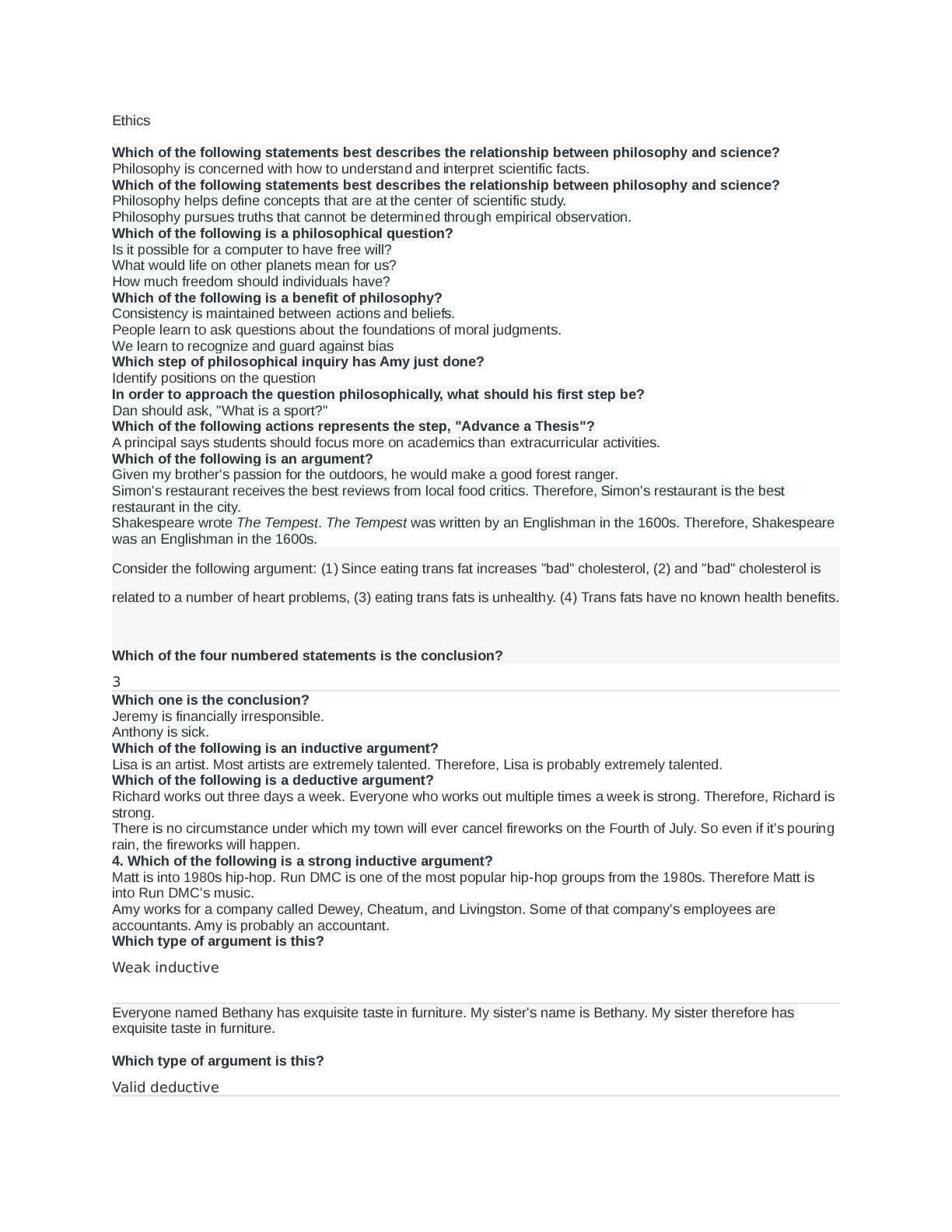
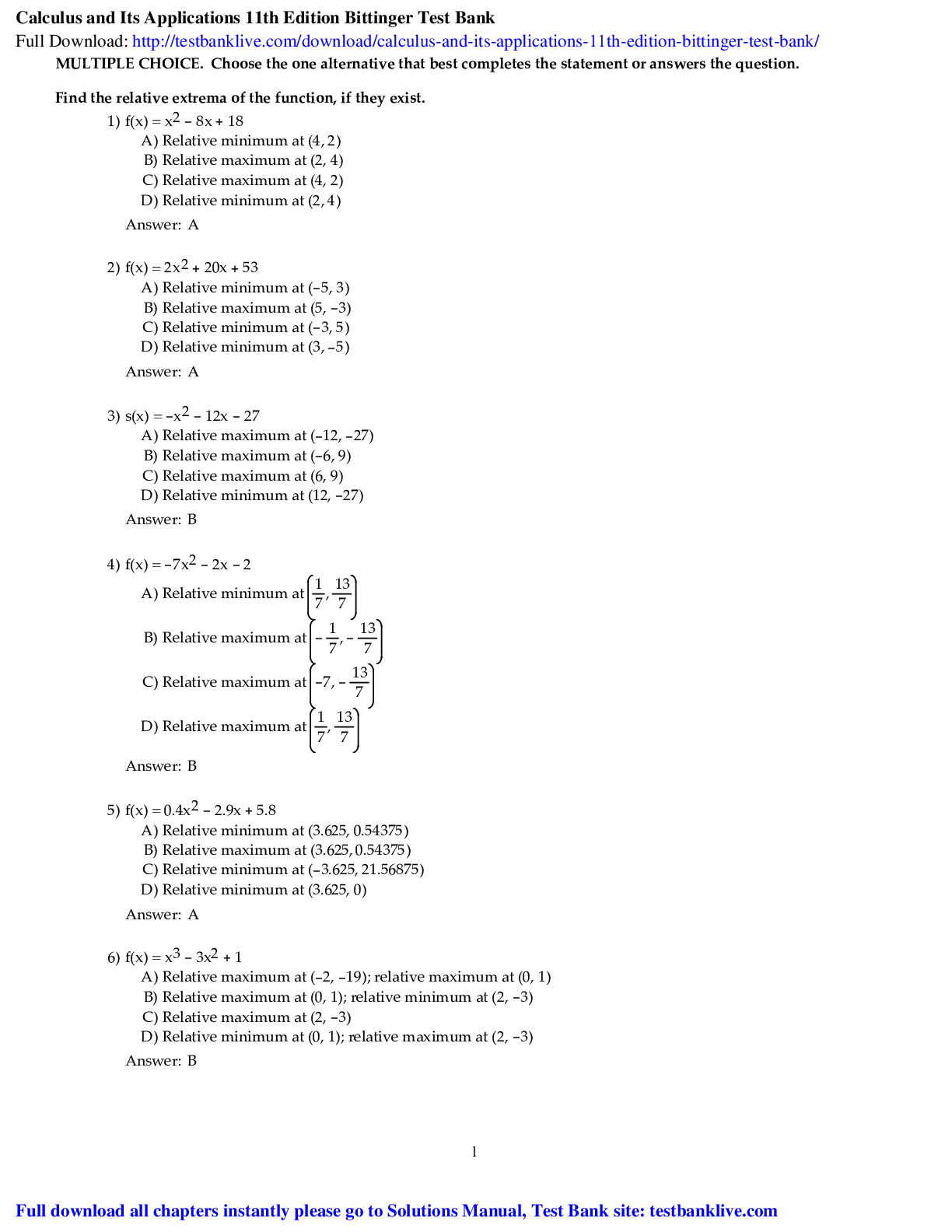

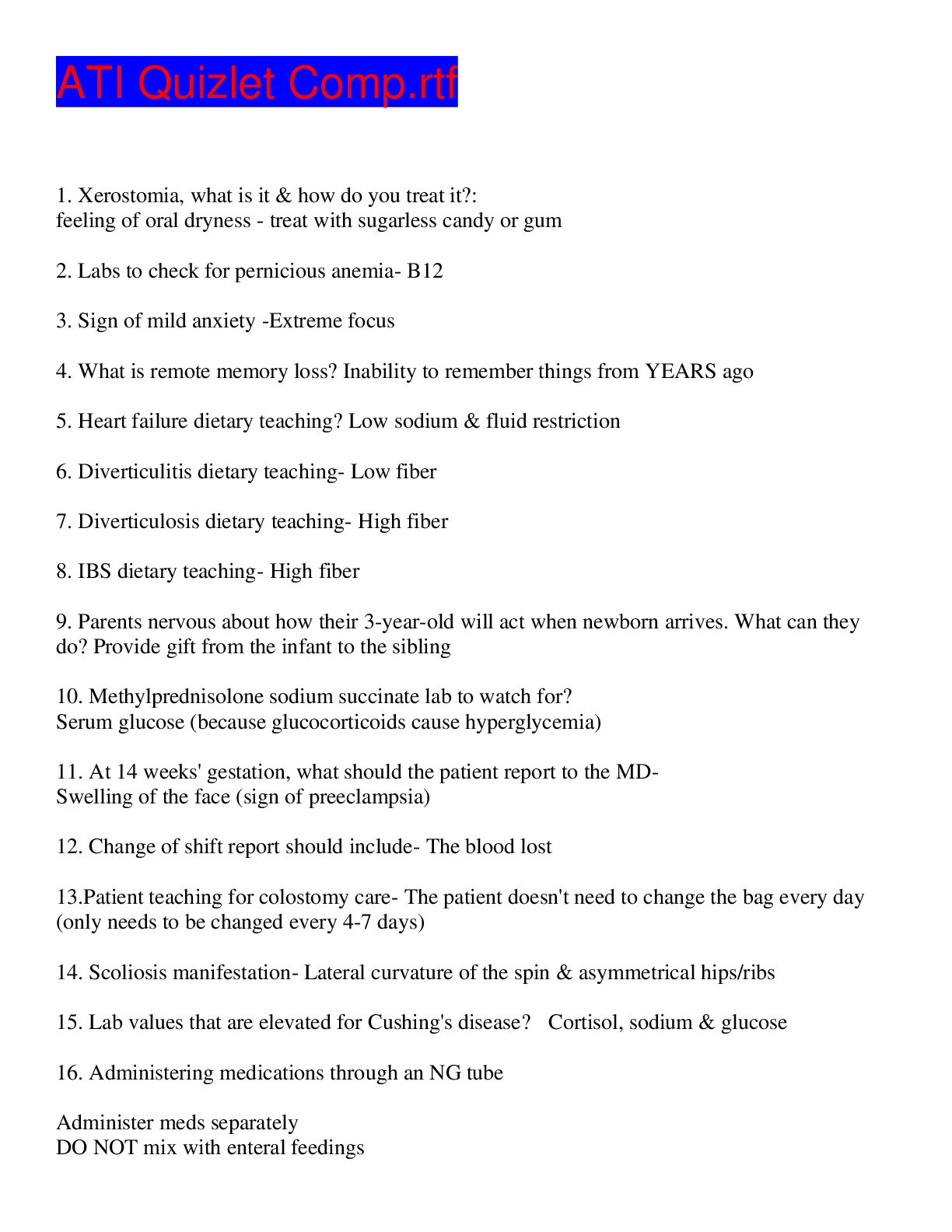
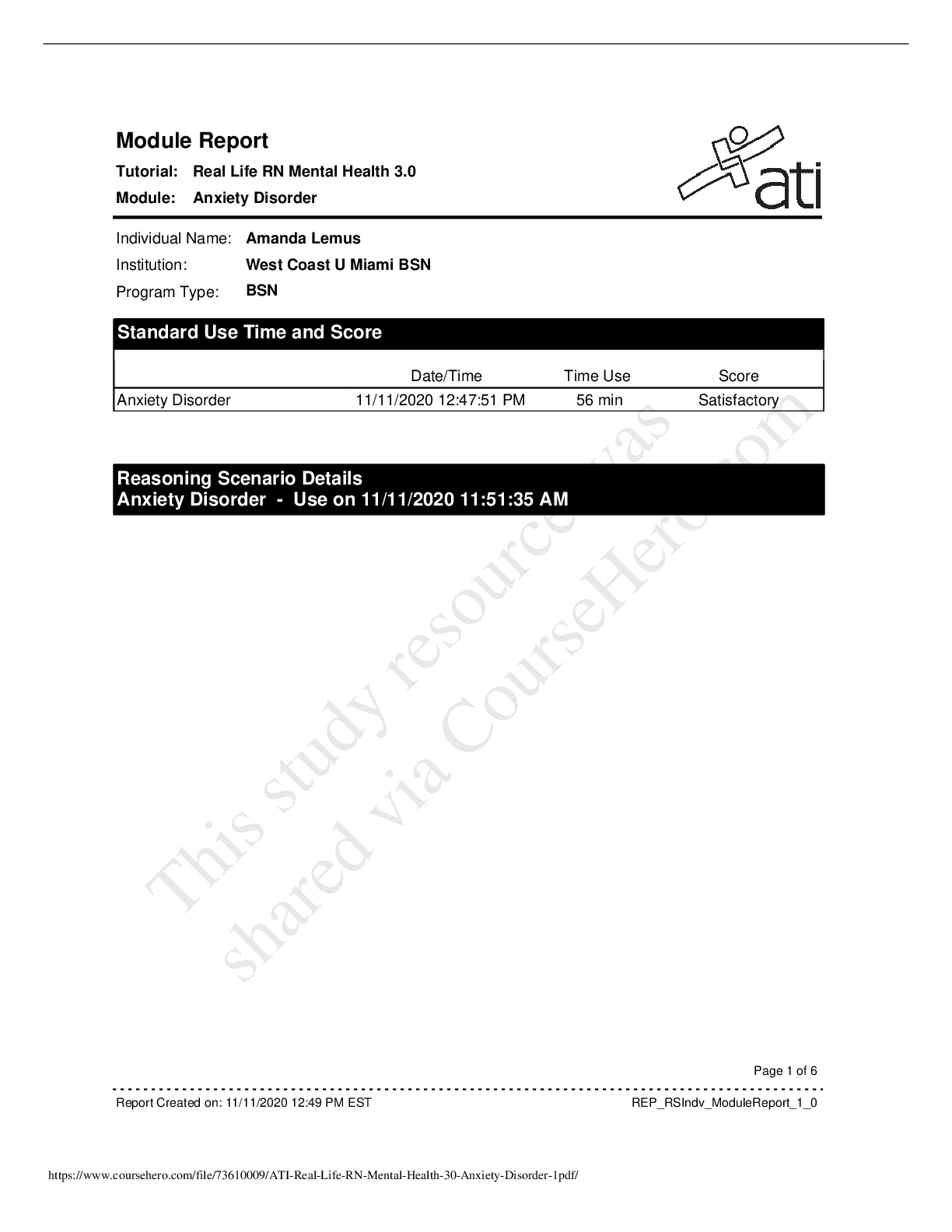
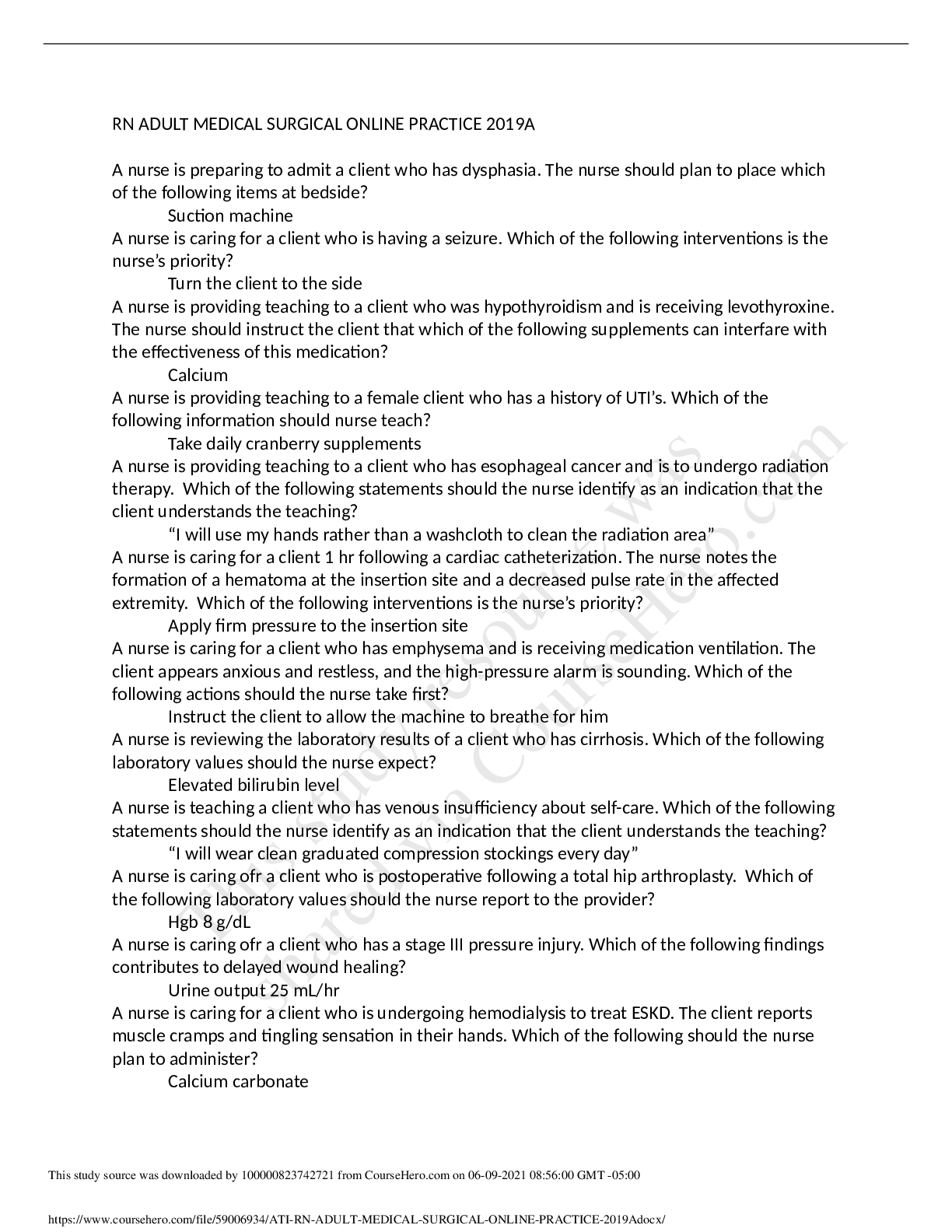


 (1).png)

 Block 1-7-2022.png)

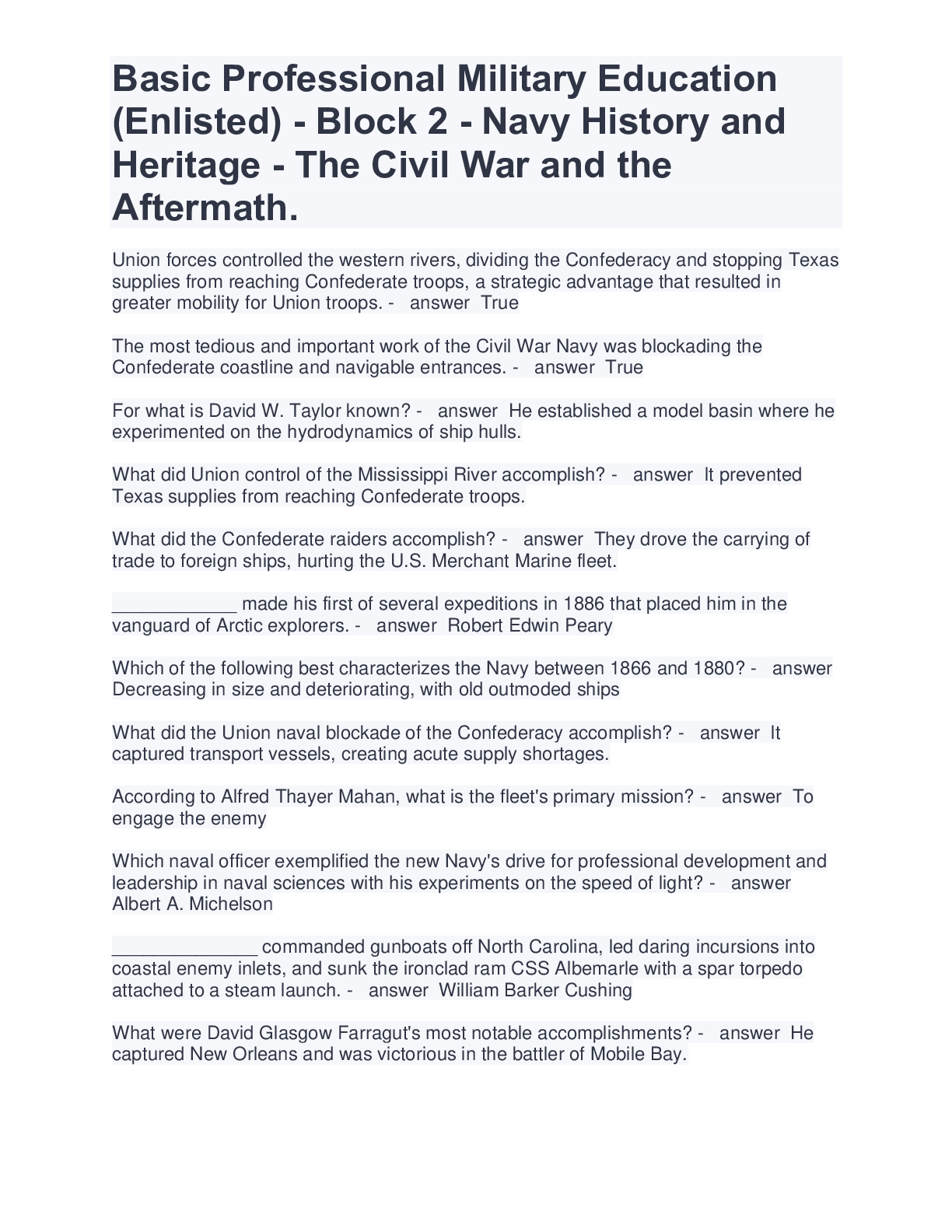
.png)
 Block 1 to 7 PPME Block 1-7 TEST BANK.png)
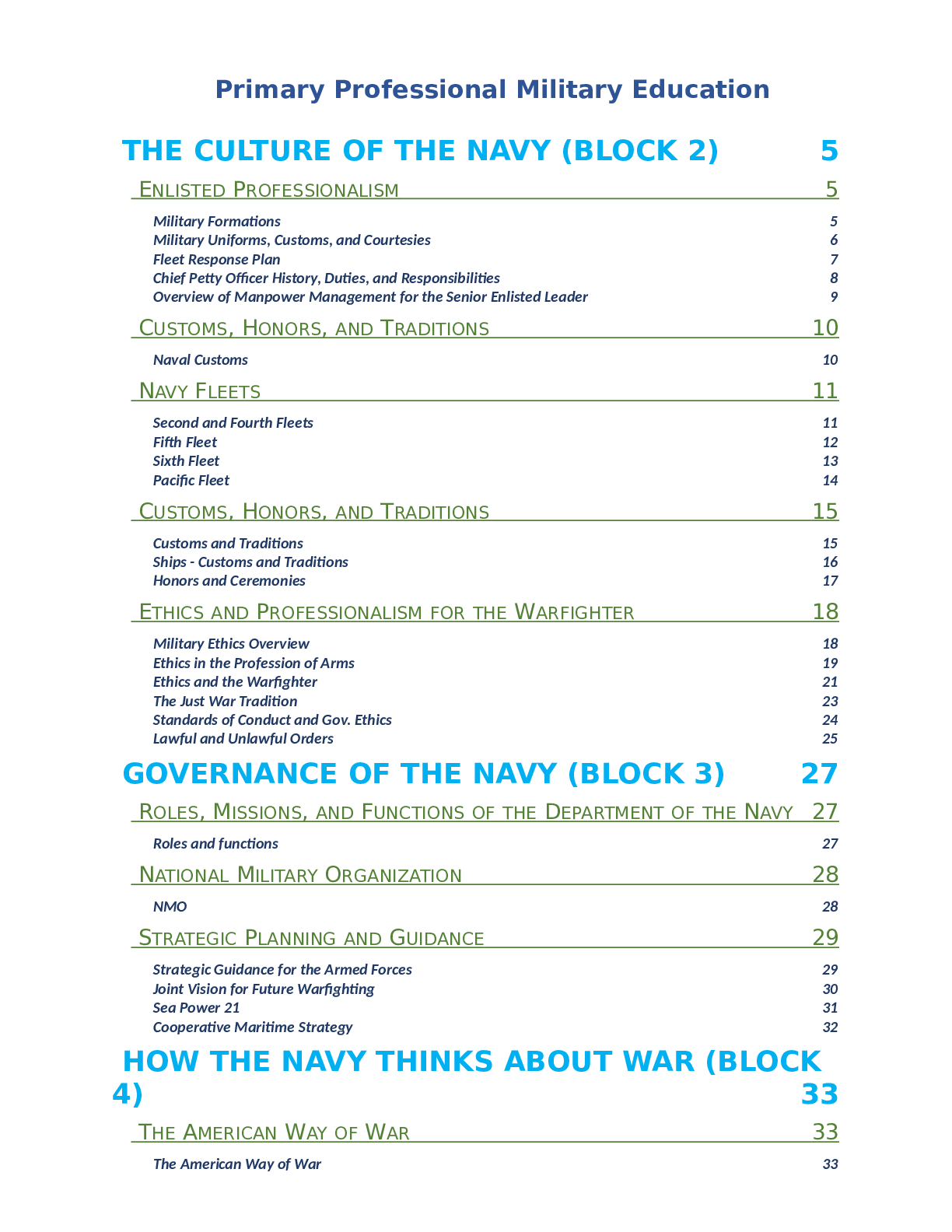
 (1).png)
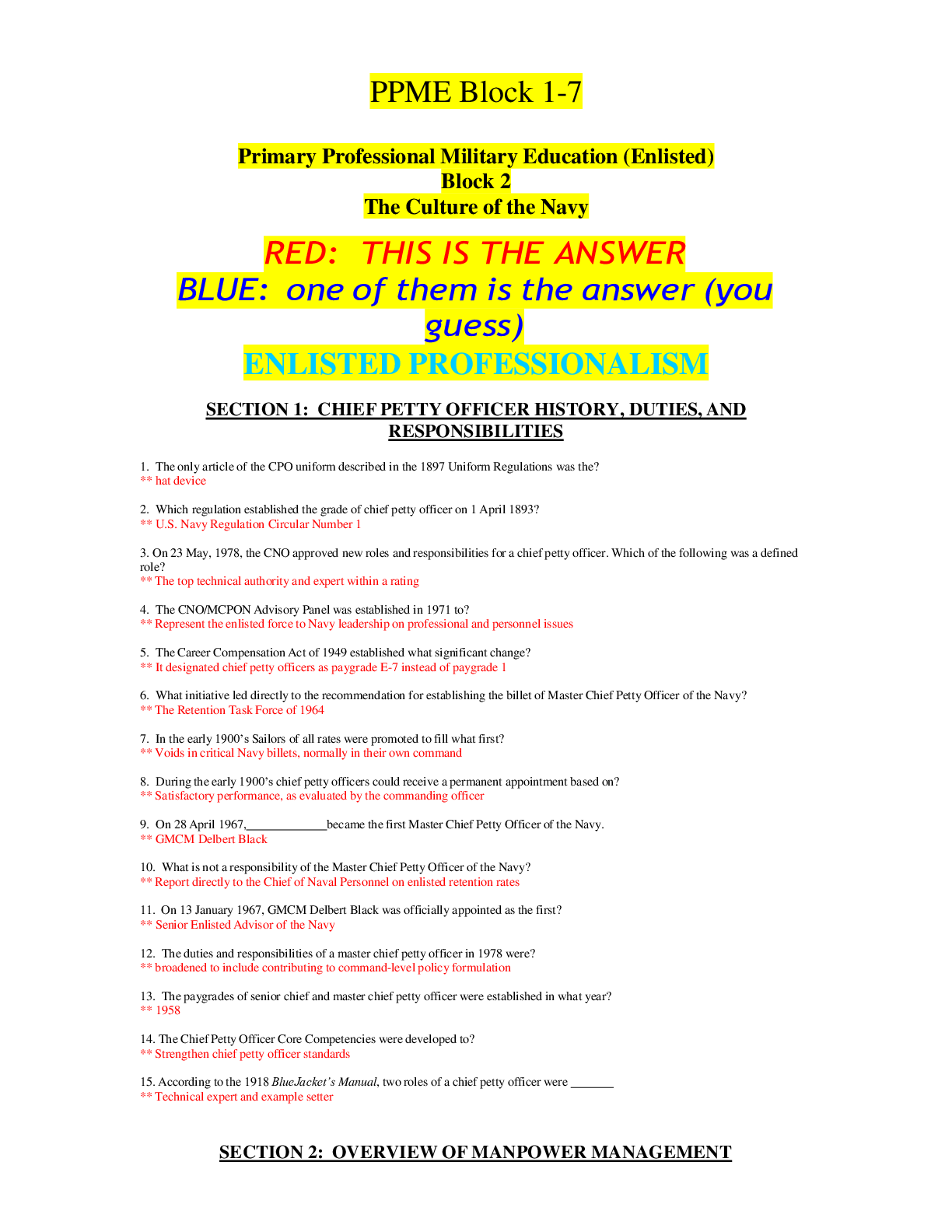
 Block 1 to 7.png)


